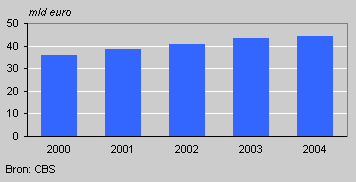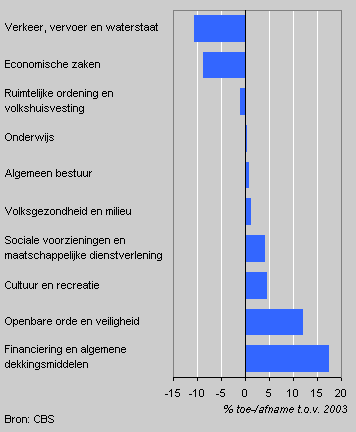Municipal spending growing more slowly

This is a revised version of a previous article.
Expenditure by Dutch municipalities is estimated to amount to 44.4 billion euro in 2004, 1.9 percent more than in 2003.
This growth rate is smaller than that in recent years. Since 2000 municipal spending has risen by 6 to 7 percent a year, among other things because of the expansion of the municipal tasks. The low growth rate can partly be explained by a number of important privatisation operations. If these are left out of account, the increase would come to 2.9 percent.
Municipal expenditure

Strong increase for spending on public order
Social provisions and social services account for the largest amounts spent (12.9 billion euro), with planning and public housing in second place (6.4 billion euro).
Spending on public order and safety rose by more than all other spending categories in 2004. According to the municipal budgets, it will rise by 12 percent to 1.1 billion euro; 0.9 billion euro of this is earmarked for fire and emergency services, 10 percent more than in 2003. Other spending on public order and safety (0.2 billion euro) rose by as much as one quarter. Rotterdam accounts for one third of this expenditure. Only in Zijpe, Tiel and Vlieland is spending per inhabitant higher. The 24 euro per capita increase in spending in Rotterdam was only exceeded in Nuenen and Cuijk.
Municipal expenditure per policy area, 2004

Substantial increase in financing expenditure
As a consequence of new accounting regulations in 2004, spending in policy areas where fixed capital formation plays an important part, such as traffic, transport and water management, and planning and housing, is decreasing. The privatisation of the Port of Rotterdam and the public transport company in Utrecht have resulted in lower costs in the area of traffic, transport and water management. These two privatisation operations have led to a decrease in expenditure of 0.4 billion euro.
Spending on financing and the general municipal fund is substantially higher. This spending concerns costs connected with loans and other costs which cannot be allocated to one of the various policy areas. This category also includes general revenues, such as revenues from municipal taxes and transfers from central government.
Opposite this increase in spending is a comparable increase in revenues. The increase was mainly caused by new accounting regulations, which result in a shift of parts of spending and revenues in some policy areas to ‘financing and the general municipal fund’. This has nor effect on total municipal expenditure and revenues.
Growth in municipal expenditure per policy area

More money for sports
Expenditure on education has hardly changed. The national picture is the net outcome of large increases and decreases in individual municipalities. Education spending decreases when schools come under private management: the funds from central government are then transferred directly to the school, and many municipalities remove these amounts from their budget. Spending on culture and recreation has risen by more than 4 percent. The increase is mainly in the area of sports and sports accommodation. Nationally, spending in this area has grown by more than 10 percent.
Ed Verburg